Sony’s E3 2009 press conference wasn’t a disaster, but it didn’t pack the punch SCE PR chiefs had planned. With no slimline PS3 announced (although that leaked packaging is almost certainly the real deal), the company’s big hardware play was the PSPgo. The new PSP was widely rumoured for months and, embarrassingly for Sony, accidentally unveiled days before the conference via PS3 video magazine Qore. Due to the leak, the official unveiling didn’t feel like a big splash – by that stage we’d all seen the press shots (some of them surprisingly ugly). At least the new PSP was finally official.
Now that the hubbub over the leak has died down and SCEA CEO Jack Tretton has gotten a few things off his chest, we’re left with the fact that a fourth iteration of Sony’s portable games console is on the way come October 1st in North America and Europe (an Australian release date is TBA). Undoubtedly, this is the most significant revision since the platform’s launch in 2004, but it’s a long way from perfect.
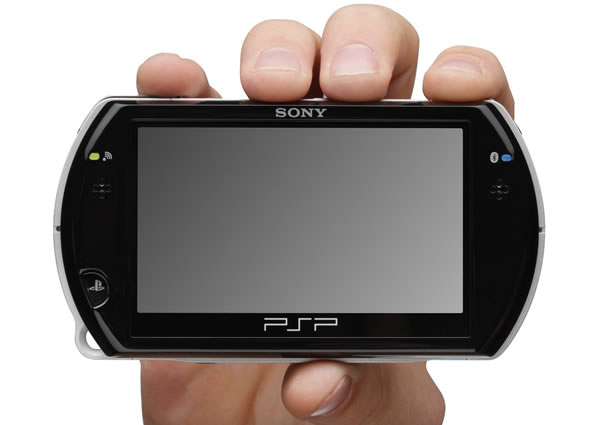
Sony's new hope - the PSPgo.
I think Sony’s made some significant missteps with the PSPgo (for the record, not the ‘PSP Go’ , ‘PSP go’ or ‘PSPGo’, despite Sony’s own initial spelling). This is a platform with enormous potential, but one that’s faced some tough, unexpected competition. The Nintendo DS, originally the underdog in the handheld gaming space, has conquered the PSP in every major territory, and Apple’s iPod touch/iPhone platform has fuelled a portable gaming explosion.
With comparatively bulky hardware, an outdated retail model, no significant onboard storage and no motion sensing or touch interfaces, the PSP 3000 obviously needed an overhaul. For those who missed Sony’s conference, that overhaul features a smaller form factor, sliding screen (slightly smaller than the current model at 3.8-inches but maintaining the same 480×272 resolution), an almost identical hardware architecture and – significantly – no UMD (Universal Media Disc) drive. Instead, Sony are offering 16GB onboard storage with the option to expand storage space via a Memory Stick Micro slot. All games will be distributed digitally through the PlayStation Store. The thing is, as sorely needed as proper PSP digital distribution has been, I don’t think these features alone will win SCE the portable war.
The Hardware
When my original imported Japanese PSP arrived packaged with Ridge Racer, Vampire Chronicle: The Chaos Tower and Everybody’s Golf, it was the sexiest hardware on Earth. It made my Game Boy Advance SP look like something from a bygone era. Since then, we’ve moved on. To be fair so has the PSP; the 2000 and 3000 models were thinner, lighter and eventually featured a microphone, but the basic form factor has remained the same. Next to my iPhone 3G, an iPod touch or even Nintendo’s DSi, the current PSP feels a little clunky.
The PSPgo attempts to addresses this problem – its design is strikingly similar to Sony’s Internet device, the Mylo 2. Featuring a sliding form factor, the screen in its closed position conceals the directional pad, four signature buttons, Start and Select. I’ve not had a chance to go hands-on with the PSPgo (I’ll have a play around next month) but by all accounts the system feels sturdy and the buttons responsive. So, what’s the problem?
Firstly (and I’ll admit, this is a personal preference), I don’t find the PSPgo very attractive. I’m not sure if it’s the newly recessed screen, the way the controls sit underneath the display or the lack of symmetry, but I haven’t warmed to the look. Plenty will argue that it doesn’t matter what a games machine looks like so long as the games are great, but given Sony’s target audience, I think it will matter a great deal. I’m sure some of my friends and colleagues would be happier sitting their iPhone 3G down at a cafe than the PSPgo – this doesn’t feel like Sony’s best industrial design work.
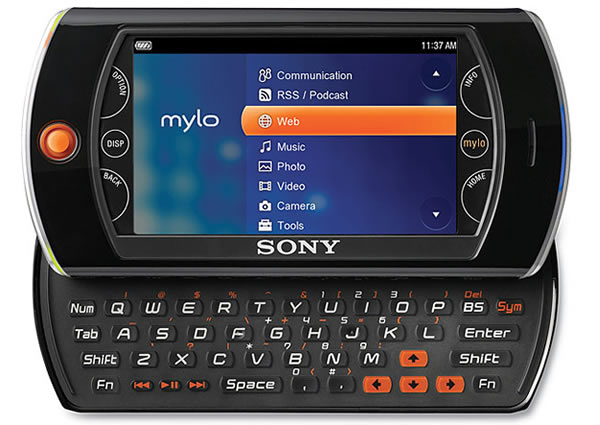
The Mylo 2. Spot any similarities? Note the PS3 Spider-Man font on the keys...
The second problem, and this is the core of my issue with Sony’s strategy, is the lack of hardware improvement. Sony didn’t even need to innovate – they could just have included newly popular and requested interfaces. Namely, a multitouch display, potentially motion sensing, a reasonable camera and, blindingly obviously, a second analogue nub. Sony’s argument for the exclusion of these features focuses on backwards compatibility – all existing PSP software re-released digitally must be playable on the PSPgo. That’s great – I’m a big supporter of backwards compatibility and think the decision to remove it from the PS3 was a mistake. What puzzles me is that none of these features – even the most basic and frequently requested, the second analogue nub – prevent games from being backwards compatible, so why not include them? Older games could simply ignore these interface options while smaller games, released exclusively via PSN, could take advantage of them.
This was a golden opportunity for Sony to reinvigorate the PSP platform without moving to a whole new hardware architecture that you’d expect from a PSP2. There’s no reason that indie games only released digitally couldn’t utilise new input mechanisms. There will also come a time when the PSP 3000 and UMD business is phased out altogether – at that point, major releases distributed only via digital channels could also utilise new interfaces. Without this stuff, Sony is missing out on the world of augmented reality, portable motion sensing and physical interaction via touch that’s becoming the benchmark thanks to Apple’s newfound gaming popularity. It’s even more bizarre given that Sony released the PSP Go!Cam for existing PSPs and they’re about to launch the camera-dependant game Invizimals (apparently unplayable on the PSPgo).
My final bugbear – less significant, but worth mentioning – surrounds PSPgo accessories. Since the launch of the PSP platform, many accessories have used the mini USB port, so it’s a fair (and obvious) assumption that Sony would keep the mini USB port on the go, right? After all, even PS3 controllers use mini USB to charge. Wrong… The PSPgo has a new proprietary port similar to the iPod/iPhone cable. That means, if you buy a PSPgo, you have to buy all your accessories again. So much for Howard Stringer committing to open standards in Sony’s future – moving from a staple interface like mini USB to a proprietary port seems plain dumb.
The Software
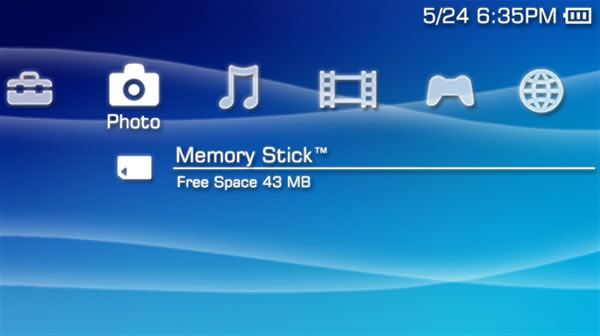
The PSP's XMB interface (resolution not to scale).
The PSPgo will, as far as we know, run on the same version of the PSP’s XMB (Cross Media Bar) operating system that can be installed on the PSP 3000. All features, including Skype support, will be included. If you haven’t used a PSP it’s a terrific interface (cleaner than the PS3 XMB counterpart), but it’s no iPod touch. You can browse photos and videos that play nice with Sony’s limited CODEC support, surf the web via a fairly limited browser and of course, connect to a configured PlayStation 3 via ‘Remote Play’, giving you IP access to media on the home console as though it’s a server. Sony will no doubt continue to improve the OS as it battles PSP piracy and adds software features to the platform, but it could have really taken the next step at an OS level with multitouch support.
The Brand
So, PSPgo ‘eh? Those of you who’ve read my thoughts on the Spider-Man turn the PlayStation logo took in 2005 will know I’m not a big fan of Sony’s recent branding – ten years of solid work seemed to disappear with the launch of the PS3. The PSPgo happily retains the three letter moniker inspired by the PS2 logo with the word ‘go’ tacked on in a new typeface to the right.
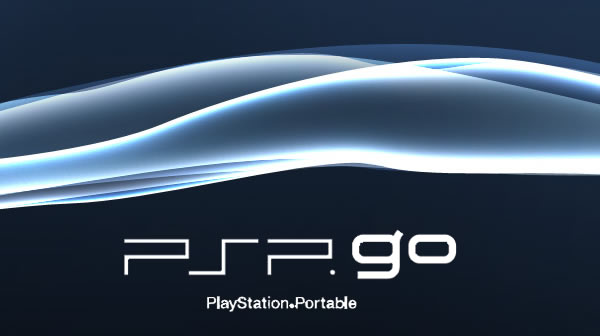
The PSPgo logo.
I don’t think it looks great, and again, there’s no consistency when compared to the rest of the PlayStation family (even the awkwardly-named Go! accessory range for older PSPs looks different). It’s interesting to note that Sony hasn’t included the ‘go’ component of the logo on the device itself; maybe the hardware team weren’t fans…
The Price – USD$249
Many of the features I’d like to see in the PSPgo would admittedly add to the manufacturing cost of the device. After the PS3, Sony knows better than anyone that launching hardware at a loss doesn’t pay when your software sales aren’t strong (depending on who you believe, the company still loses AUD$150 to AUD$200 on each PS3 sold). But here’s the thing – when you break it down, the USD$249 PSPgo should theoretically be cheaper to manufacture than the current PSP 3000 (USD$169) given the lack of a disc drive.
Of course, Sony has every right to make a profit on its hardware – Nintendo’s been doing this with the Wii and DS for years now. All the same, I’m not sure if that price is the sweet spot for what’s essentially four year old hardware. (Note that the PSPgo’s official Australian price and release date have not yet been announced – the current PSP 3000 sells for an AUD$299 RRP).
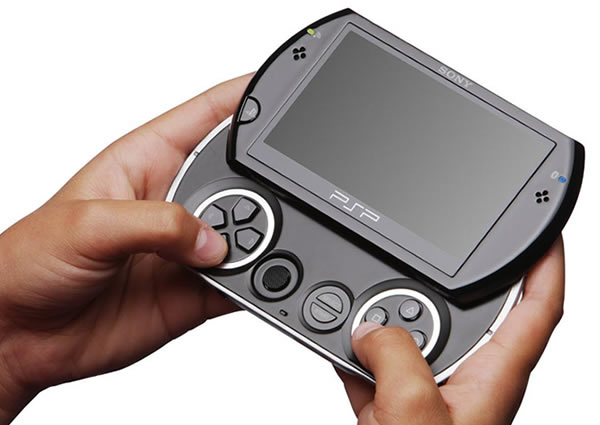
Sony, we need to talk about the position of that analogue nub.
I’m sure I’ll end up picking up a PSPgo – all my criticisms aside, this is a significant step forward for Sony’s portable, and credit where credit’s due, the platform holder has done a terrific job of revitalising third party support to coincide with the go’s public debut. It’s just a shame that Sony’s missed the opportunity to introduce real portable gaming evolution this time around, and in the face of increasingly fierce competition, I wonder if SCE can afford to stick with what’s come before.



















Discussion
No comments for “PSPgo – the good, the bad and the ordinary”